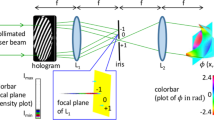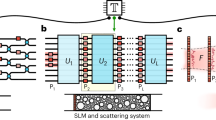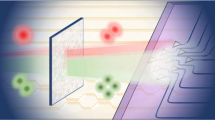Abstract
Modes of propagation through an optical system are generally defined as the eigensolutions of the wave equation in the system. When propagation occurs through complicated or highly scattering media, however, modes are better identified as the best orthogonal communication channels to send information between sets of input and output apertures. Here we determine the optimal bidirectional orthogonal communication channels through arbitrary and scattering optical systems using photonic processors. The processors consist of meshes of electrically tuneable Mach–Zehnder interferometers in silicon photonics. The meshes can configure themselves based on simple power maximization or minimization algorithms, without external calculations or calibration or any prior knowledge of the optical system. The identification of the communication mode channels corresponds to a singular value decomposition of the entire optical system, autonomously performed by the photonic processors. We observe crosstalk below –30 dB between the optimized channels even in the presence of distorting masks or partial obstructions. In these cases, although the beams bear little resemblance to conventional mode families, they still show orthogonality. These findings offer potential for applications in multimode optical communication systems, promising efficient channel identification, adaptability to dynamic media and robustness against environmental challenges.
This is a preview of subscription content, access via your institution
Access options
Access Nature and 54 other Nature Portfolio journals
Get Nature+, our best-value online-access subscription
$29.99 / 30 days
cancel any time
Subscribe to this journal
Receive 12 print issues and online access
$209.00 per year
only $17.42 per issue
Buy this article
- Purchase on Springer Link
- Instant access to full article PDF
Prices may be subject to local taxes which are calculated during checkout




Similar content being viewed by others
Data availability
All the data supporting the findings of this study are available within this Article and its Supplementary Information. Any additional data are available from the corresponding author on reasonable request.
Code availability
The computer codes that support the plots within this paper and other findings of this study are available from the corresponding author upon reasonable request.
Change history
05 December 2023
A Correction to this paper has been published: https://doi.org/10.1038/s41566-023-01361-3
References
Cox, M. A. et al. Structured light in turbulence. IEEE J. Sel. Topics Quantum Electron. 27, 1–21 (2021).
Hill, R. J. Optical propagation in turbulent water. J. Opt. Soc. Am. 68, 1067–1072 (1978).
Matthès, M. W., Bromberg, Y., de Rosny, J. & Popoff, S. M. Learning and avoiding disorder in multimode fibers. Phys. Rev. X 11, 021060 (2021).
Vellekoop, I. M. & Mosk, A. P. Focusing coherent light through opaque strongly scattering media. Opt. Lett. 32, 2309–2311 (2007).
Yoon, S. et al. Deep optical imaging within complex scattering media. Nat. Rev. Phys. 2, 141–158 (2020).
Biton, N., Kupferman, J. & Arnon, S. OAM light propagation through tissue. Sci. Rep. 11, 2407 (2021).
Ishimaru, A. The beam wave case and remote sensing. in Laser Beam Propagation in the Atmosphere. Topics in Applied Physics (ed Strohbehn, J. W.) 129–170 (Springer, 1978).
Heck, M. J. R. Highly integrated optical phased arrays: photonic integrated circuits for optical beam shaping and beam steering. Nanophotonics 6, 93–107 (2017).
Nape, I. et al. Revealing the invariance of vectorial structured light in complex media. Nat. Photon. 16, 538–546 (2022).
Churnside, J. H. & Lataitis, R. J. Wander of an optical beam in the turbulent atmosphere. Appl. Opt. 29, 926–930 (1990).
Gong, L. et al. Optical orbital-angular-momentum-multiplexed data transmission under high scattering. Light Sci. Appl. 8, 27 (2019).
Miller, D. A. B. Waves, modes, communications, and optics: a tutorial. Adv. Opt. Photon. 11, 679–825 (2019).
Miller, D. A. B. Communicating with waves between volumes: evaluating orthogonal spatial channels and limits on coupling strengths. Appl. Opt. 39, 1681–1699 (2000).
Miller, D. A. B. Establishing optimal wave communication channels automatically. J. Lightwave Technol. 31, 3987–3994 (2013).
Miller, D. A. B. Self-configuring universal linear optical component. Photon. Res. 1, 1–15 (2013).
Harris, N. C. et al. Linear programmable nanophotonic processors. Optica 5, 1623–1631 (2018).
Zhou, H. et al. Chip-scale optical matrix computation for PageRank algorithm. IEEE J. Sel. Topics Quantum Electron. 26, 8300910 (2020).
Bogaerts, W. et al. Programmable photonic circuits. Nature 586, 207–216 (2020).
Zhou, H. et al. Photonic matrix multiplication lights up photonic accelerator and beyond. Light Sci. Appl. 11, 30 (2022).
Pai, S. et al. Experimental evaluation of digitally verifiable photonic computing for blockchain and cryptocurrency. Optica 10, 552–560 (2023).
Shen, Y. et al. Deep learning with coherent nanophotonic circuits. Nat. Photon. 11, 441–446 (2017).
Shokraneh, F., Geoffroy-gagnon, S. & Liboiron-Ladouceur, O. The diamond mesh, a phase-error- and loss-tolerant field-programmable MZI-based optical processor for optical neural networks. Opt. Express 28, 23495–23508 (2020).
Tian, Y. et al. Scalable and compact photonic neural chip with low learning-capability-loss. Nanophotonics 11, 329–344 (2022).
Pai, S. et al. Experimentally realized in situ backpropagation for deep learning in photonic neural networks. Science 380, 398–404 (2023).
Tzarouchis, D. C., Mencagli, M. J., Edwards, B. & Engheta, N. Mathematical operations and equation solving with reconfigurable metadevices. Light Sci. Appl. 11, 263 (2022).
Harris, N. C. et al. Quantum transport simulations in a programmable nanophotonic processor. Nat. Photon. 11, 447–452 (2017).
Milanizadeh, M. et al. Coherent self-control of free-space optical beams with integrated silicon photonic meshes. Photon. Res. 9, 2196–2204 (2021).
Miller, D. A. B. Analyzing and generating multimode optical fields using self-configuring networks. Optica 7, 794–801 (2020).
Milanizadeh, M. et al. Separating arbitrary free-space beams with an integrated photonic processor. Light Sci. Appl. 11, 197 (2022).
Bütow, J. et al. Spatially resolving amplitude and phase of light with a reconfigurable photonic integrated circuit. Optica 9, 939–946 (2022).
Miller, D. A. B. Self-aligning universal beam coupler. Opt. Express 21, 6360–6370 (2013).
Annoni, A. et al. Unscrambling light-automatically undoing strong mixing between modes. Light Sci. Appl. 6, 17110–17110 (2017).
Fontaine, N. K. et al. Space-division multiplexing and all-optical MIMO demultiplexing using a photonic integrated circuit. In National Fiber Optic Engineers Conference PDP5B.1 (Optica Publishing Group, 2012).
Harris, N. C. et al. Efficient, compact and low loss thermo-optic phase shifter in silicon. Opt. Express 22, 10487–10493 (2014).
Rahim, A. et al. Taking silicon photonics modulators to a higher performance level: state-of-the-art and a review of new technologies. Adv. Photon. 3, 024003 (2021).
Choutagunta, K., Roberts, I., Miller, D. A. B. & Kahn, J. M. Adapting Mach-Zehnder mesh equalizers in direct-detection mode-division-multiplexed links. J. Lightwave Technol. 38, 723–735 (2020).
Tzang, O. et al. Wavefront shaping in complex media with a 350 kHz modulator via a 1D-to-2D transform. Nat. Photon. 13, 788–793 (2019).
Zanetto, F. et al. Dithering-based real-time control of cascaded silicon photonic devices by means of non-invasive detectors. IET Optoelectronics 15, 111–120 (2021).
Xue, Y. et al. High-speed and low dark current silicon-waveguide-coupled III-V photodetectors selectively grown on SoI. Optica 9, 1219–1226 (2022).
Fatemi, R., Khial, P. P., Khachaturian, A. & Hajimiri, A. Breaking FOV-aperture trade-off with multi-mode nano-photonic antennas. IEEE J. Sel. Topics Quantum Electron. 27, 6100614 (2021).
Sacher, W. D., Huang, Y., Lo, G.-Q. & Poon, J. K. S. Multilayer silicon nitride-on-silicon integrated photonic platforms and devices. J. Lightwave Technol. 33, 901–910 (2015).
Milanizadeh, M., Aguiar, D., Melloni, A. & Morichetti, F. Canceling thermal cross-talk effects in photonic integrated circuits. J. Lightwave Technol. 37, 1325–1332 (2019).
Zemtsov, D. S. et al. Broadband silicon grating couplers with high efficiency and a robust design. Opt. Lett. 47, 3339–3342 (2022).
Lu, Z. et al. Broadband silicon photonic directional coupler using asymmetric-waveguide based phase control. Opt. Express 23, 3795–3808 (2015).
Poulton, C. V. et al. Long-range LiDAR and free-space data communication with high-performance optical phased arrays. IEEE J. Sel. Topics Quantum Electron. 25, 7700108 (2019).
Acknowledgements
S.S., G.F., M. Sampietro, M. Sorel, A.M. and F.M. acknowledge support from the European Commission under the Horizon 2020 Programme (SuperPixels, grant no. 829116). S.S., M. Sorel, A.M. and F.M. acknowledge support from the Italian National Recovery and Resilience Plan (NRRP) of NextGenerationEU, partnership on ‘Telecommunications of the Future’ (PE00000001—program ‘RESTART’, Structural Project ‘Rigoletto’ and Focused Project ‘HePIC’). D.A.B.M. acknowledges support by the Air Force Office of Scientific Research (AFOSR, grants FA9550-17-1-0002 and FA9550-21-1-0312). Part of this work was carried out at Polifab, the micro- and nanofabrication facility of Politecnico di Milano (https://www.polifab.polimi.it/). We thank C. De Vita for his support in the realization of the phase masks used in the experiments and V. Grimaldi for his support in the development of the control electronics.
Author information
Authors and Affiliations
Contributions
M.M. and S.S. designed the photonic chips and performed the optical measurements. F.Z., G.F. and M. Sampietro developed the electronic control systems. M. Sorel contributed to the design of the photonic chip. S.S., M.M., A.M., D.A.B.M. and F.M. conceived the experiments and analysed the experimental data. S.S., D.A.B.M. and F.M. wrote the manuscript. All the authors contributed to the revision of the manuscript. F.M. supervised the project.
Corresponding author
Ethics declarations
Competing interests
The authors declare no competing interests
Peer review
Peer review information
Nature Photonics thanks Keren Bergman, Dirk Englund and the other, anonymous, reviewer(s) for their contribution to the peer review of this work.
Additional information
Publisher’s note Springer Nature remains neutral with regard to jurisdictional claims in published maps and institutional affiliations.
Extended data
Extended Data Fig. 1 Beam shapes of orthogonal modes between arbitrary sets of optical apertures.
Complete set of beam pairs (far fields \({{{\Psi }}}_{{\hat{{{{\bf{u}}}}}}_{1,2}}\) and \({{{\Phi }}}_{{\hat{{{{\bf{v}}}}}}_{1,2}}\)) measured when the number of input M / output N apertures in the source/receiving volumes are progressively reduced, a in a non-symmetric configuration (M = 9, 8, . . . , 5; N = 9), and b in a (point-)symmetric configuration (M = N = 9, 8, . . . , 5).
Extended Data Fig. 2 Coupling strength of mode pairs established between arbitrary sets of optical apertures.
Simulated coupling strengths of modes established between the source/receiving volumes when the number of input M and output N apertures are progressively reduced a in a non-symmetric configuration (M = 9, 8, . . . , 5; N = 9), and b in a (point-)symmetric configuration (M = N = 9, 8, . . . , 5). Coupling strengths are normalized to that of the first mode when M = N = 9. Experimental data are shown in Fig. 2b,c, while measured beam shapes are reported in Extended Data Fig. 1.
Extended Data Fig. 3 Orthogonal modes through obstacles and scattering media.
The full set of obstacles used in the experiments include metal obstructions arranged as a periodic pattern of a circles (and laterally shifted in b), c donuts, d crosses, and e a microscale reproduction of the Politecnico di Milano logo. The far-field beam shapes of the first two modes \({{{\Psi }}}_{{\hat{{{{\bf{u}}}}}}_{1,2}}\) providing the maximum coupling strengths and the minimum mutual cross-talk through these obstacles are shown. For each case, bar charts show the coupling strength (σij, i = j) and the mutual cross-talk (σij, i ≠ j), which are both deteriorated with the insertion of the obstacle (dashed bars, before configuration), and can be mostly recovered by optimizing the two photonic processors (solid bars, after configuration). In the experiments reported in panel f the obstacle is a phase aberrator emulated by using an SLM; the recovery of the coupling strength (σij, i = j) and the mutual cross-talk (σij, i ≠ j) is shown for 11 different example configurations of the SLM. The peak-to-peak phase shift introduced by the phase-only aberrator is 2π.
Supplementary information
Supplementary Information
Supplementary Sections 1–3, Figs. 1–4 and caption for Video 1.
Supplementary Video 1
Camera view of the measured far field of the first (mode 1; left) and second (mode 2; right) modes during the automated setting performed by the two-processor system. The experimental conditions are the ones considered in Fig. 1e. ‘Reset’ operations correspond to random settings of all the phase actuators of the two meshes, which are scrambled at each trial. To better appreciate the mode evolution, the control algorithm is intentionally slowed down and is paused at each reset. Two modes are sequentially established (search for mode 2 starts after the convergence of mode 1); however, for a better comparison, the evolution of the two modes is shown together in the video.
Rights and permissions
Springer Nature or its licensor (e.g. a society or other partner) holds exclusive rights to this article under a publishing agreement with the author(s) or other rightsholder(s); author self-archiving of the accepted manuscript version of this article is solely governed by the terms of such publishing agreement and applicable law.
About this article
Cite this article
SeyedinNavadeh, S., Milanizadeh, M., Zanetto, F. et al. Determining the optimal communication channels of arbitrary optical systems using integrated photonic processors. Nat. Photon. 18, 149–155 (2024). https://doi.org/10.1038/s41566-023-01330-w
Received:
Accepted:
Published:
Issue Date:
DOI: https://doi.org/10.1038/s41566-023-01330-w
This article is cited by
-
Interferometer meshes for low-crosstalk scalable optical chips
Nature Reviews Electrical Engineering (2024)
-
Empowering high-dimensional optical fiber communications with integrated photonic processors
Nature Communications (2024)
-
Demixing microwave signals using system-on-chip photonic processor
Light: Science & Applications (2024)



